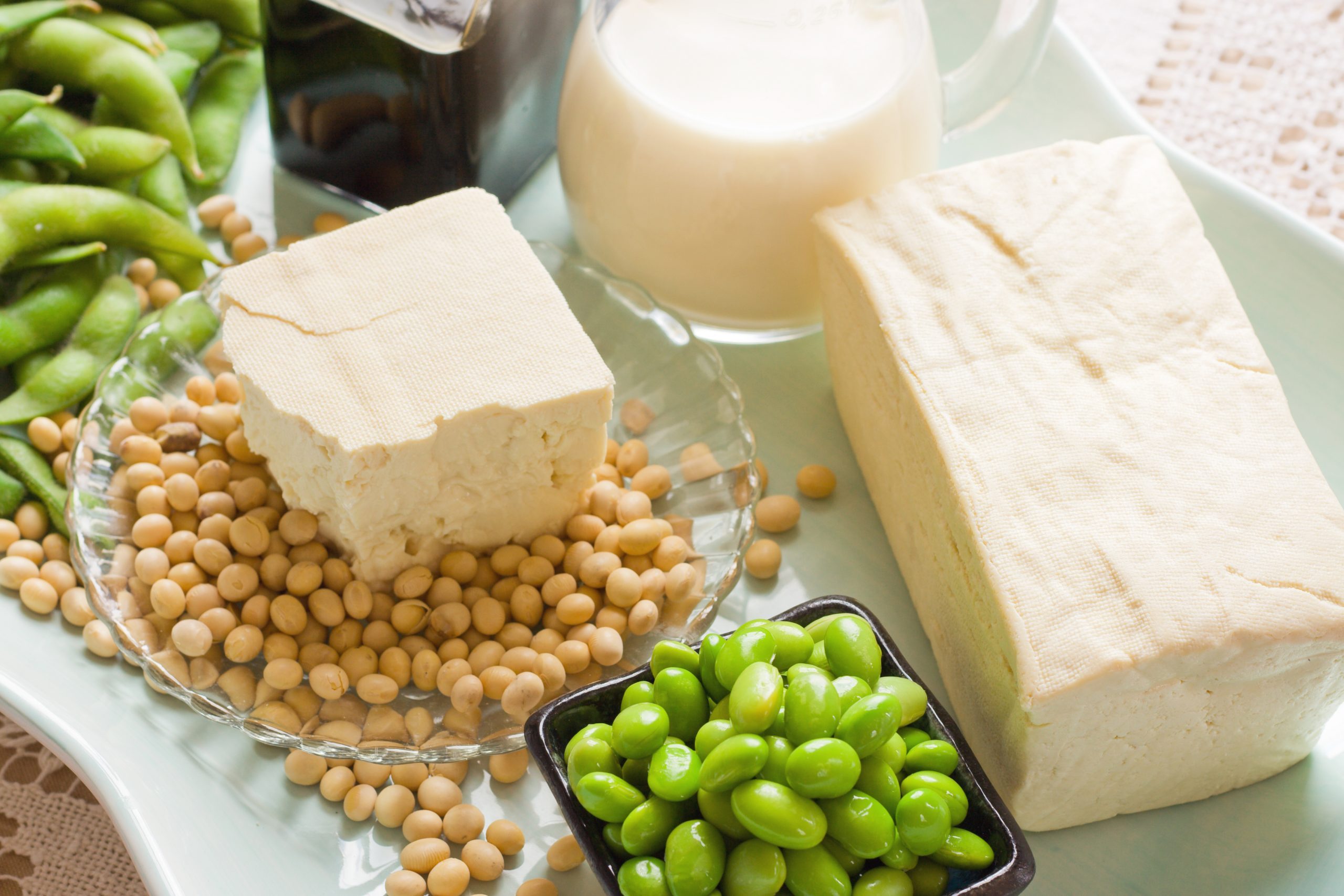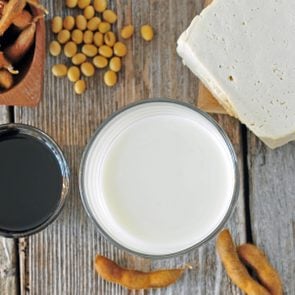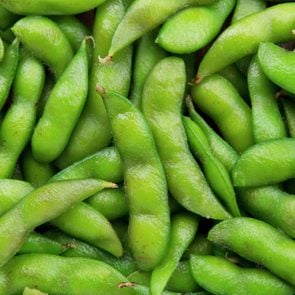Is Eating Soy Good or Bad for You?
Updated: Mar. 16, 2022
When it comes to your health, is eating soy bad for you? Experts explain the types of soy as well as their nutrition and health benefits. Plus learn the truth about common soy myths.
Our editors and experts handpick every product we feature. We may earn a commission from your purchases.
What is soy exactly?
Soy foods have been a staple in Asia for at least 1,500 years. These foods are increasingly popular in the United States, too, largely due to their potential health benefits and the growing number of people who are embracing a plant-based lifestyle.
Made by processing soybeans, soy can be found in many foods and drinks, including edamame (whole, immature soybeans in the pod), miso, soy protein, tofu, tempeh, soy cheese, nondairy yogurt, soy-based ice cream, soy milk, and more. But is soy bad for you?
By and large, soy is very, very good for you—unless you have a soy allergy, says Leah Kaufman, a registered dietitian at NYU Langone Health’s Weight Management Program in New York City.
Soy is low in artery-clogging cholesterol, rich in bone-building calcium, and is a complete source of protein for people who adhere to vegetarian diets. Soy is also chock full of vitamins and minerals and high in fiber, she says.
Soybeans nutrition facts
Here’s a peek at some of the nutrition packed into 1 cup (172 g) of boiled soybeans, plus how much of the recommended daily value (DV) each cup contains:
Calories: 296
Protein: 31.3 g
Total fat: 15.4 g (23 percent DV)
Cholesterol: 0 mg
Carbs: 14.4 g (5 percent DV)
Fiber: 10.3 g (40 percent DV)
Calcium: 175 mg (18 percent DV)
Iron: 8.84 mg (49 percent DV)
Potassium: 886 mg (25 percent DV)
Types of soy foods
Edamame
These are whole, young soybeans, sold both in pods or as shelled beans.
A popular snack, bright green edamame beans are high in protein and fiber. One cup has 18.5 grams of protein.
Miso
Miso is a rich, salty soy paste often used as a base for soup and in sauces and marinades. It’s made from soybeans that are mixed with salt, a type of mold, and rice or other grain, all of which is then fermented.
Soy milk
When you order coffee, you have more milk choices than ever before, and soy milk is a popular one—with good reason: One cup has 6.34 grams of protein, 300 mg of calcium and is rich in B vitamins. It’s made from cooked soybeans and water.
Soy nuts
These are made from mature soybeans are are often baked or roasted. A small single serving of roasted soy nuts is high in protein and isoflavones (plant-based estrogens).
Soy sauce
While this condiment may have originated in Asia, it’s used throughout the United States in meals like stir-fries and sushi. It’s traditionally made by fermenting soybeans, wheat, salt, and mold to produce a liquid with a salty and umami flavor. (Find out if coconut aminos is healthier than soy sauce.)
Tempeh
Tempeh is made from cooked and fermented soybeans that are then formed into a dense cake. Most tempeh includes grains such as rice or millet. A serving size is about 3.5 ounces and has more than 20 grams of protein.
Textured soy protein
Textured soy protein is the umbrella term for products made from textured soy flour.
“You can create a texture that resembles meat,” explains Sharon Palmer, a registered dietitian nutritionist in Ojai, California, and author of California Vegan. “It’s not as ‘whole’ as tofu, which is basically made from grinding soybeans, filtering them with water into a soy milk, and then coagulating it. However, they are rich in protein, and this can be a great, functional, easy-to-use meat alternative.” (These are the best vegan protein sources to try.)
Tofu
Tofu, or soybean curd, is rich in high-quality protein and B vitamins, and low in sodium. It’s made by pressing curdled soybeans into solid blocks.
(Tempeh vs. tofu: here’s how these two compare.)
Protein in soy foods
Some soy foods have more protein than others. Soy foods high in protein include textured soy protein, soy flour, whole soybeans, tempeh, tofu, and soy milk. Soy sauce and miso, by contrast, contain minimal soy protein and are high in salt.
Protein helps your body repair its cells and make new ones. (Soy is just one of the best plant-based protein sources.)

Potential health benefits of soy
Boosts heart health
Experts agree that, for most people, the benefits of consuming soy far outweighs any risks. For starters, it’s good for your heart.
“Soy, when consumed as part of a healthy diet, can lower blood pressure because it’s not high in sodium at all,” Kaufman says. (Certain soy products, like miso and soy sauce, are very high in salt, however.) High blood pressure raises your chance of developing heart disease.
Soy is also one of the foods that help lower triglycerides, dangerous blood fats that raise your heart disease risk.
A review study in The Journal of Nutrition found that soy protein may help decrease low-density lipoprotein (LDL) “bad” cholesterol levels. That’s a good thing because high cholesterol is another risk factor for heart disease.
Consuming certain soy foods really does slash the risk for heart disease: Participants who ate at least one serving of tofu a week had an 18 percent lower risk of heart disease compared with those who rarely ate tofu, and this benefit was greatest among young women before menopause and postmenopausal women who were not taking hormones, according to research in Circulation.
Soy is also lower in calories than many other proteins, which means it can help keep weight down. That’s a key benefit since obesity is linked to a host of diseases and conditions, including heart disease and type 2 diabetes.
Lowers breast cancer risk
Despite soy’s stellar lineup of nutrients, it can get a bad rap, Kaufman says. Soy is rich in isoflavones, plant-based phytoestrogens that function like a weaker form of the female sex hormone estrogen. This has led to concerns that soy may confer similar health risks to estrogen.
Although estrogen is known to feed certain breast cancers, consumption of soy foods is actually associated with a lower risk of breast cancer, says Marisa Weiss, MD, chief medical officer and founder of Breastcancer.org and Breasthealth.org.
“This lower risk is mostly seen in studies in which people are using soy as their main source of protein, rather than red or processed meats,” she says. Processed and red meats, on the other hand, are associated with an increased risk of breast cancer.
It’s worth noting that most of these studies looked at soy food intake. That means soy protein powder, which wasn’t examined, may not have the same benefit.
“Soy foods—like edamame, soy milk, or tofu and textured soy protein—are healthy,” says Dr. Weiss, who serves as the director of breast radiation oncology and breast health outreach at Lankenau Medical Center in Wynnewood, Pennsylvania. “However, we don’t yet know if extracted concentrated soy powders are safe, as they can be high doses of just the protein without the other healthy ingredients within soy.”
Soy may also reduce the risk of other cancers, including colon and prostate cancers. High-fiber diets are known to lower the risk for colon cancer, and soy foods are rich in fiber. A review of 30 studies in Nutrients found that isoflavones in soy, namely genistein and daidzein, may block the development and growth of prostate cancer.
Helps with kidney function
Kidneys are filters that don’t let proteins pass through, but if you have kidney disease, protein may seep through, says Mache Seibel, MD, an obstetrician/gynecologist affiliated with Beth Israel Deaconess Medical Center in Boston and author of The Estrogen Fix.
“The protein in soy is cleared by your kidneys with minimal effort,” he says. “If you want to be kind to your kidneys, soy is a great food to include in your diet.”
(How healthy are your kidneys? Here are the signs of kidney disease.)
Reduces hot flashes during menopause
Soy can help cool hot flashes.
“If you have had breast cancer and can’t take estrogen replacement therapy to reduce hot flashes, soy is an option,” Dr. Seibel says. “Estrogen may be a superior treatment for hot flashes, but as far as supplements or foods go, soy can turn down the heat and may be the difference between a disrupted or satisfactory night’s sleep.”
Why is that important? Many women in menopause have drenching night sweats that interrupt their ability to get a good night’s sleep.
Facts and myths about soy foods
Myth: You can’t eat soy if you are on thyroid medication
It’s a myth that you can’t eat soy if you are on medication to keep your thyroid functioning optimally.
“This is not true,” says Dr. Seibel. “If you are taking thyroid medication at the same time as you eat soy, it will interfere. But if you don’t do it at the same time, it’s fine.”
The solution: Eat soy at a different time of the day than when you take your thyroid medication.
Myth: It causes breast enlargement in men
In the past, people feared that higher levels of plant-based estrogen from eating soy could affect hormonal balance and lead to male breast enlargement. This is not the case.
“People are afraid that because soy contains plant-based estrogen, it will increase risk of breast cancer or different problems related to breasts, but there is no data to support this,” Dr. Seibel says.
Concerns that children who eat soy will reach puberty earlier have also been put to rest. For instance, a study in Nutrition Reviews found that that soy does not negatively affect hormonal levels in children or cause earlier puberty.
Fact: Soy can cause allergies
There is no controversy here. If you are allergic to soy, you should avoid it, Kaufman says.
Soy is one of the top eight allergens in the United States, along with milk, eggs, peanuts, tree nuts, fish, shellfish, and wheat. (Learn more about foods that cause allergies.)
How to get more soy in your diet
When it comes to adding soy to your diet—and accruing health benefits—you have a lot of options.
“Soy protein adapts to any flavor,” says Dr. Seibel. “You could take tofu or soy protein and mix it with ground beef when making burgers, and you’d cut down the amount of saturated fat and get the same taste.”
He also recommends people use soy milk to make pancakes, oatmeal, or cream of wheat. You may want to try tofu in stir-fries or smoothies, tempeh in soups or chili, and edamame sprinkled over salads. (Check out these edamame recipes everyone can enjoy.)
Moderation is important. Aim for 25 to 50 milligrams of soy protein per day, Dr. Seibel says.
Not all soy-based foods are created equal, and this affects nutritional value.
“I recommend minimally processed soy foods—such as edamame, tofu, tempeh, and soy milk—compared to more-processed soy foods, such as soy protein powders,” Palmer says.
The beneficial elements of soy (the fiber, protein, healthy carbs, vitamins, minerals, and phytochemicals) are more pronounced in heavily processed soy products than in whole-plant foods. “It’s harder to overdo on one food when you eat them in whole form versus isolates or supplements,” she says.
(Soy is one of many probiotic-filled foods to add to your diet.)
The last word
Unless you are allergic to soy, this protein-rich food confers more health benefits than risks.
Along with following a healthy diet and being physically active, replacing high-fat animal proteins with soy is an easy way to reduce your risk of health conditions like heart disease.
There are many ways to enjoy soy, but it’s best to stick to whole foods over supplements.
Next, here are some plant-based swaps to replace common ingredients.



